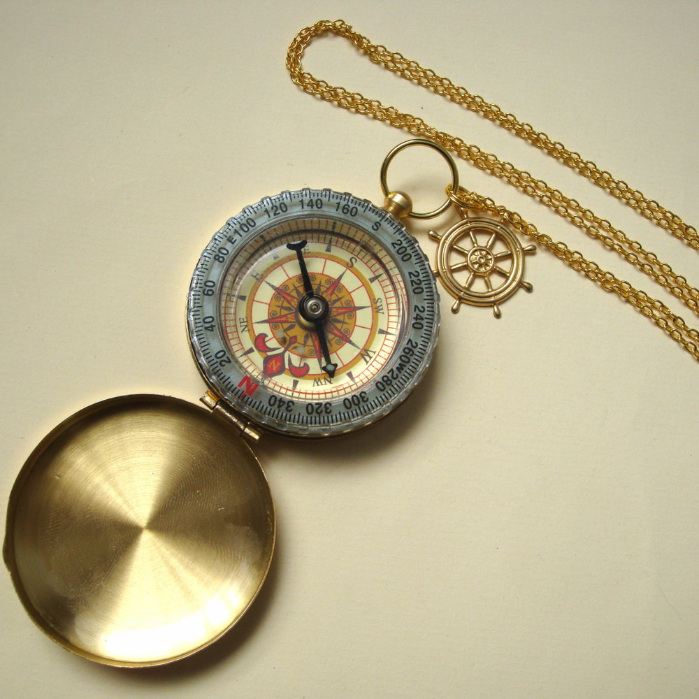Magnetic North vs Geographic North
Why does a compass point north? Understanding why a compass points north involves differentiating between magnetic north and geographic north. Geographic north, commonly known as true north, is the direction pointing towards the North Pole. It’s a fixed point on our planet’s surface. In contrast, magnetic north is where a compass needle actually points, aligning with Earth’s magnetic field.
Magnetic north is not a constant point; it shifts due to changes in the Earth’s molten outer core. Currently, magnetic north lies approximately ten degrees from the geographic North Pole. This difference means that if you’re navigating using a compass, it won’t lead you exactly to the geographic North Pole but to an invisible point in the Arctic that changes location over time.
Navigators have known for centuries that compasses don’t align with the North Star, Polaris, due to this discrepancy. Early compass users observed that the direction their compasses pointed and the position of Polaris did not match, sparking inquiry into what is now known as magnetic declination, or variation.
The intricacy of the Earth’s magnetic field arises from circulating currents of liquid iron in the outer core. This creates the magnetic poles, which are different from the geographic poles due to the differing mechanisms that create them.
In 2019, a rare occurrence took place at Greenwich where magnetic north and true north aligned, confirming the dynamic nature of Earth’s magnetic field. This alignment was temporary, however, and magnetic north continues to slowly migrate over time.
Navigating with a compass, sailors must adjust their course based on the magnetic declination of their location. This invisible force greatly influences navigation. Understanding the difference between magnetic north and geographic north is vital for accurate orientation and successful journeys, whether one is exploring land or traversing the seas.
The Earth’s Magnetic Field Explained
The wonder of compasses finding north lies in the Earth’s magnetic field. Imagine the planet as a giant magnet. Deep within, liquid iron moves, creating this invisible force field. This movement generates magnetic poles, invisible points near the Earth’s surface. These are different from the fixed geographic poles, the top and bottom points of the Earth’s spin axis.
A compass aligns with these magnetic poles, not geographic North. Why does a compass point north? It’s actually pointing to magnetic north. This point keeps shifting due to changes in the Earth’s core. Therefore, navigators need to know their current location’s magnetic declination. Magnetic declination is the angle between magnetic north and true north.
As liquid iron swirls in the outer core, the Earth’s magnetic field changes. This results in the magnetic poles’ slow dance across the globe. Today, compasses point about ten degrees away from the geographic North Pole. In different places or times, this number can change.
In essence, compass needles are guided by our planet’s magnetic song. This directs explorers across seas and lands alike. So, a compass needle’s northward pointer is a dance with Earth’s magnetic rhythm.
Understanding Earth’s magnetic field is key. It’s a compass’s map and a navigator’s legend. As Earth spins and iron flows, the magnetic field guides our journeys. This unseen, moving force is why compasses point north, but not true north.
Historical Changes in Earth’s Magnetic Poles
The Earth’s magnetic poles are not fixed and have been moving throughout history. In the past, the north magnetic pole was once near the geographic north pole, but over time it has migrated considerably. Changes in Earth’s core, where molten iron flows and generates magnetism, cause this movement. This liquid iron acts like a bar magnet at the center of the Earth, but its effects are not static.
Various historical records show that these poles have shifted considerably. Ancient navigators, using early compasses, discovered that their instruments did not consistently align with the North Star, Polaris. This prompted investigations into magnetic declination – the difference between compass north (magnetic north) and true north (geographic north).
Magnetic declination varies by location and changes over time. For mariners and explorers, understanding and adjusting for this declination has been critical for accurate navigation. Documents over the centuries have kept track of these variations, helping to navigate safer and more precisely.
Historically, this has not just been a topic of practical concern for navigators but also of scientific curiosity for understanding Earth’s inner workings. The north magnetic pole, for instance, has zigzagged from the Canadian Arctic to the middle of the Arctic Ocean over recent years.
Significant movement was first documented during the 19th-century ‘Magnetic Crusade,’ where explorers and scientists measured magnetic variation around the world. It’s now a known fact that the Earth’s magnetic field is dynamic, leading to ever-changing navigation challenges.
Today, thanks to satellite technology and continuous monitoring, we have a better understanding of the rate and pattern of these changes. This has profound implications for navigation, requiring ongoing adaptation in the use of magnetic compasses for determining direction.
The Role of Earth’s Core in Magnetic Orientation
The Earth’s core is central to our planet’s magnetic field and, consequently, how compasses orient themselves. This vast, swirling reservoir of molten iron and nickel generates a vast magnetic field enveloping our planet, affecting everything from compass directions to the behavior of charged particles from the sun.
At the heart of it, the outer core’s movement causes magnetic north to shift. These constant changes are due to the dynamic nature of the molten iron flows, which act like a giant, irregularly-shaped bar magnet. Interaction between Earth’s rotation and the liquid metal generates the magnetic field, hence influencing compass needles worldwide.
To visualize this, think of Earth as a spinning top with iron at its center. This iron isn’t static but moves in convection currents. These currents are due to the intense heat within the core causing the metal to move in patterns that change over time. It’s these movement patterns that cause the magnetic poles to wander across the surface of the planet.
Currents within the core are not only perpetually in motion but also very erratic, which makes the exact position of magnetic north hard to pinpoint. Over time, and with the outer core’s ongoing circulation, magnetic north will continue to meander, a fact navigators must account for when journeying across the globe.
In essence, the reason a compass points north is due to the enigmatic dance of molten metals deep within Earth’s core, an area inaccessible but incredibly influential to surface navigation. Understanding this complex interaction helps mariners and explorers correct their course and maintain direction amidst Earth’s ever-changing magnetic realm.
Magnetic declination plays a critical role in navigation. It is the angle between magnetic north and true north. This angle changes depending on where you are on Earth. It also shifts over time due to the Earth’s core dynamics.
Why does a compass point north, but not true north? This is due to magnetic declination. A compass is directed by Earth’s magnetic field, not the geographic poles.
Navigators must adjust for this variance. They use charts and tools to find their true course. Without these adjustments, their route would be off, leading to errors.
Compass users have long been aware of this difference. Ancient sailors noticed their compasses didn’t always match Polaris, the North Star.
Today’s explorers still use magnetic declination maps. These tools help them stay on the right path.
In short, understanding magnetic declination is key for accurate navigation. It sheds light on why a compass points north, and how to use it right.
Long ago, sailors used the stars to find their way at sea. When clouds hid the stars, compasses helped them navigate. These early tools showed the way by pointing to magnetic north, not true north. As we’ve learned, this is because of Earth’s magnetic field.
In the 12th century, Europeans started using compasses for sea navigation. By the 16th century, they were vital for sailors. But the compass needle doesn’t actually point to the geographic north pole. It points to magnetic north, which shifts over time. Because of this, sailors had to adjust their routes.
Scientists wanted to understand why compasses didn’t always point true north. They studied Earth’s magnetism on land and sea. This work was known as the Magnetic Crusade. They learned that the Earth’s core movements changed the magnetic field.
Now, GPS has changed navigation again. Ships now use GPS for direction, guided by satellites. Today’s captains still train with compasses, though. That’s because technology can fail. A compass is a trusted tool if GPS stops working.
Compasses may seem old-fashioned next to GPS. But they still teach us about Earth’s magnetic field. And they remind us of our journey to understand our planet. Navigators once relied on compasses alone. Now, we use both the stars and satellites to find our way.
Magnetic Storms and Compass Anomalies
Magnetic storms can cause compass needles to act oddly. These storms are solar eruptions that send charged particles to Earth. The Earth’s magnetic field gets disturbed. This can make compass readings unreliable for a short time. Sailors have feared these storms for centuries. Unseen solar activity would turn their trusted compasses into foes, leading them astray.
In high latitudes, the impact of magnetic storms is stronger. The magnetic field lines are steeply inclined here. This makes the horizontal field that compasses read less stable. Sudden shifts can occur. A compass might swing wildly, confusing navigators.
Alaska’s experience is telling. For over 100 years, the Sitka magnetic observatory has monitored the Earth’s magnetic field. It saw compasses veer off by more than 10 degrees in just hours. Maps must be updated with new declination values regularly to stay current.
Despite GPS, compasses are still vital for ships at sea. Captains learn to navigate with compasses as a backup. Understanding magnetic storms and their effects is part of this training. It helps them keep safe when technology fails and the sea turns unpredictable.
In summary, magnetic storms create temporary compass anomalies. Mariners must be aware of these when navigating the high seas. Navigation tools and knowledge must be up-to-date to ensure safety during these magnetic disturbances.
As technology evolves, compass navigation too faces a future of innovation. Advances in understanding Earth’s magnetic complexities pave the way for better navigation tools. Here is what we can expect:
- Enhanced Magnetic Declination Maps: New research could provide more accurate, real-time declination data. This will make compass use more precise.
- Compass-Integrated Devices: Smartphones and watches may have improved compass features. These could offer real-time updates and navigational aids.
- Advanced Calibration Techniques: Methods to calibrate compasses with local magnetic anomalies could become easier and more widespread.
- Global Positioning System (GPS) Developments: While GPS dominates navigation, it depends on external tech. Compasses serve as a reliable backup when technology fails.
- Education in Navigation: As awareness grows, more adventurers will learn to navigate confidently with both compass and GPS tools.
- Marine and Aeronautical Advances: For safety, ships and planes will upgrade their navigation systems, blending traditional and modern tech.
The compass, an ancient tool, has guided travelers for centuries. Even with global satellite networks, understanding why does a compass point north remains fundamental. As we move forward, so too will the trusty compass, adapting and enhancing the way we explore the world.



